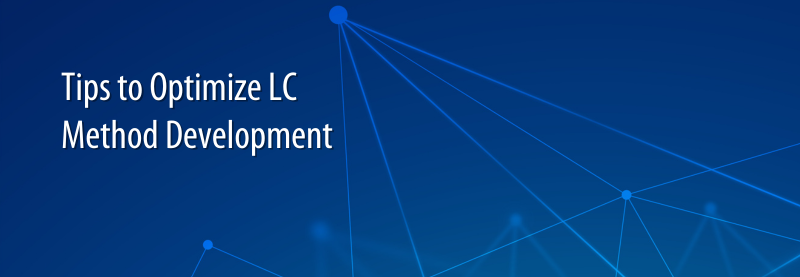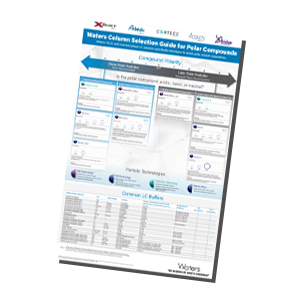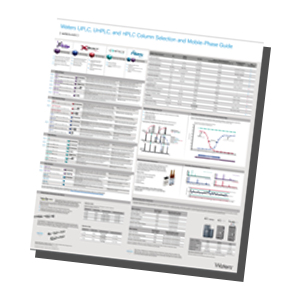
Series overview
1. The first module will cover a simple and easy performance monitoring process that is not tied to a specific assay, allowing more flexibility in testing.
2. The second module will look at the different method development approaches. The approach selected should be based on sample complexity, and the need for a fast, traceable method development process.
3. The third module looks at the importance and limitations of using both low pH and high pH modified mobile phases as a part of method development. While switching between the two is highly beneficial from a selectivity standpoint, column stationary phases have limitations that analysts should be aware of.
4. The fourth module looks at the different selectivity that can be achieved by using alternate mobile phase strong solvents. By using methanol instead of acetonitrile, additional retention mechanisms can be realized promoting alternative selectivity, especially on certain stationary phases.
5. The fifth module looks at the column stationary phases in more detail. Discussions of particle morphology, particle type, and bonded ligand are made with recommendations for where each is most applicable.
6. The final module brings the topic to instrument contributions on column and assay performance. Considerations of system dwell as it relates to column internal diameter are made.
Learning Outcomes
• Understand the difference between a system suitability injection and a qualification check
• Be able to set up a system performance monitoring procedure
• Understand the four main approaches to method development
• Understand the benefits and limitations of using manual vs software assisted method development
• Use pKa to determine (approx.) what pH a compound should be tested at
• Understand how alternating between low and high pH can drive selectivity in method development.
• How using acetonitrile vs methanol will affect selectivity when using certain column chemistries, especially Phenyl-hexyl and PFP phases.
• How to select a column based on the analytes of interest instead of selecting columns based on past research
• Build a panel of columns to assist with method development.
• Understand how the different systems affect method development.
• How to properly select column configurations based on the system being used.
Plus, download these additional resources
 [Wall Chart] Waters Column Selection Guide for Polar Compounds Wall Chart — This wall chart helps in the selection of waters columns for analysis of polar compounds and includes Waters HILLIC columns and reverse-phase LC columns specifically developed to tackle polar analyte Separation.
[Wall Chart] Waters Column Selection Guide for Polar Compounds Wall Chart — This wall chart helps in the selection of waters columns for analysis of polar compounds and includes Waters HILLIC columns and reverse-phase LC columns specifically developed to tackle polar analyte Separation.
 [Wall Chart] Waters Column Selection Guide for Polar Compounds Wall Chart — This wall chart helps in the selection of waters columns for analysis of polar compounds and includes Waters HILLIC columns and reverse-phase LC columns specifically developed to tackle polar analyte Separation.
[Wall Chart] Waters Column Selection Guide for Polar Compounds Wall Chart — This wall chart helps in the selection of waters columns for analysis of polar compounds and includes Waters HILLIC columns and reverse-phase LC columns specifically developed to tackle polar analyte Separation.

[Wall Chart] Waters UPLC, UHPLC, and HPLC Column Selection and Mobile Phase Guide — This wall chart details about Waters UPLC, UHPLC, and HPLC column selection and mobile phase guide.
 [Wall Chart] Simplified Column Selection and Method Development — In this wall chart the Column screening performed and showed that the XSelect Premier HSS PFP using methanol mobile phases provided the best separation, meeting all criteria.
[Wall Chart] Simplified Column Selection and Method Development — In this wall chart the Column screening performed and showed that the XSelect Premier HSS PFP using methanol mobile phases provided the best separation, meeting all criteria.
 The Presenter
The Presenter
Kenneth Berthelette
Senior Scientist, Waters Corporation Chemistry and Consumables Group
Waters Corporation Chemistry and Consumables Group
Ken earned his Bachelor’s of Science degree in Professional Chemistry from Bridgewater State University, Bridgewater Massachusetts, in 2010. He has been with Waters Corporation since March 2012 and has worked on several product launches including CORTECS columns, UPC2 Torus and Trefoil columns, and the Atlantis Premier BEH Z-HILIC column. He changed job functions in 2021 and now supports Chemistry Aftermarket initiatives. His focus on applications and customer education has led to several seminars and webinars on topics including method development, method modernization and transfer, HILIC separation techniques, and LC system troubleshooting.